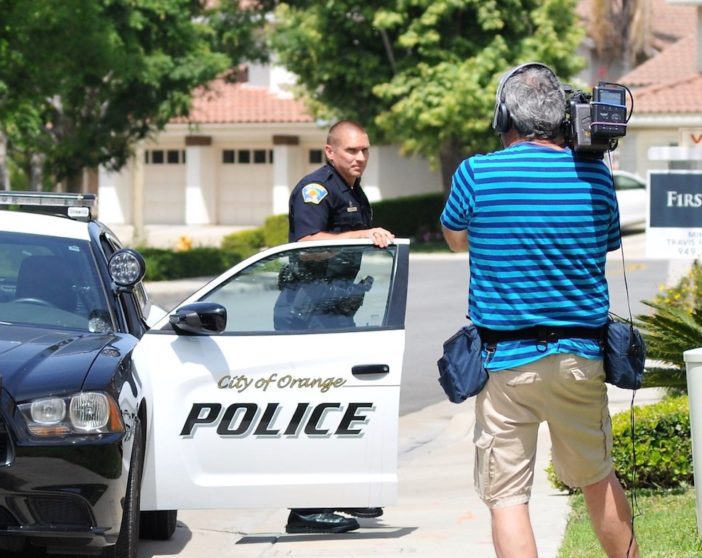A distraught U.S. Army veteran suffering from PTSD attaches one end of a hose to the exhaust pipe of his SUV and the other end into the driver’s side window, cracked up just enough for the hose to fit.
After pinging his cell phone to get his location, Cpl. Mark Bailey and Officer Kyle Bean of the Orange Police Department are first to respond and see the SUV in the driveway.
They stay far enough away to be safe, yet close enough to communicate with the suicidal veteran.
As Bean develops a rapport with the vet, Bailey sneaks to the rear of the SUV and yanks the hose apart from the exhaust pipe.

Videographer Mark Kiss (left) shoots a scene with Orange PD Cpl. Mark Bailey (center) and Officer Kyle Bean during the making of an instructional video on how officers should contact individuals with PTSD. Photo by Lou Ponsi/Behind the Badge OC
After chatting for several minutes, Bean convinces the man to get out of the vehicle and accept their help.
The encounter ends peacefully.
While based on an actual incident that occurred about a year ago, everyone in this scenario was acting, including the veteran, who was portrayed by Orange PD Det. John Mancini.
With the camera rolling, the scene was being recreated for the latest in a series of six pioneering training videos produced by the Orange PD that focus on police contacts with mentally ill subjects.
Past videos, all involving scenarios that are recreated by police personnel, have addressed autism, bipolar disorder, schizophrenia and Alzheimer’s disease. And they’ve won the Orange PD recognition, including the James Q. Wilson award for excellence in policing.
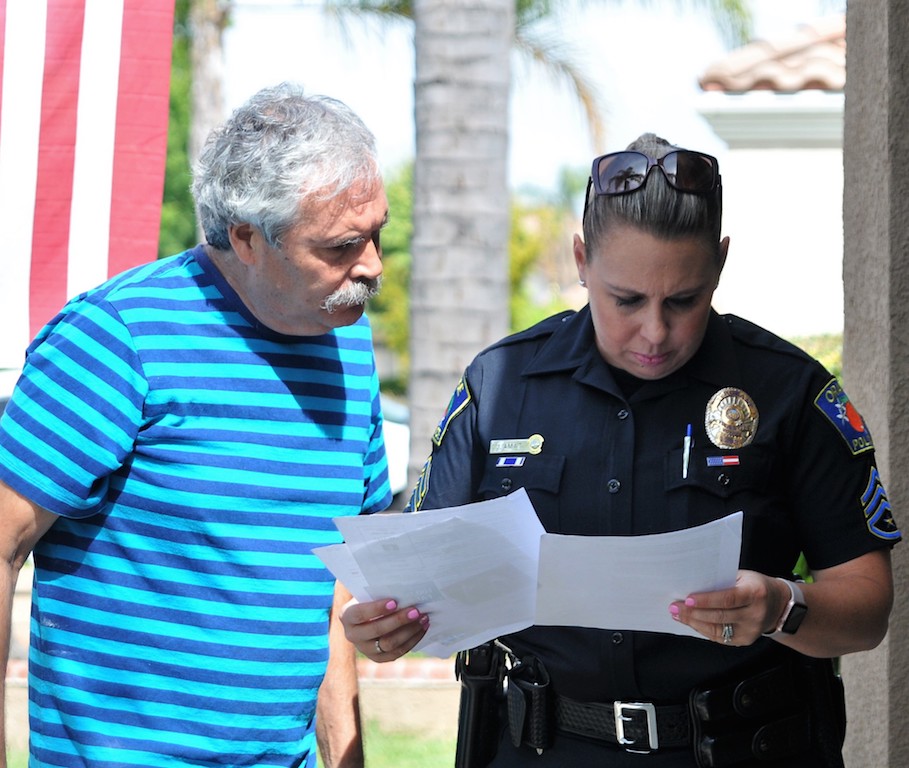
Videographer Mark Kiss of the Santa Ana Police Department and Orange PD Sgt. Jennifer Amat go over the script for an instructional video that will be used for training law enforcement professionals on dealing with people with PTSD. Photo by Lou Ponsi/Behind the Badge OC
“They are all geared towards law enforcement’s interaction with mental illness and how to better serve that population,” said Orange PD Sgt. Jennifer Amat, who oversees the productions. “It’s just new ways of thinking and better ways of dealing with people who have these issues.”
In a past video addressing autism, the scenario involved a young boy who left home in the middle of the night to go buy the newest video game.
Officers arrive and just walk alongside him, chatting him up about the video game, rather than screaming, ‘”Stop! Sit down on the curb,’” Amat said. Many people on the autism spectrum may not understand the role of an officer and become confused and intimidated. The situation may be unfamiliar and therefore stressful to him or her — causing even more problems.

Det. John Mancini of Orange PD, left, plays the role of a suicidal Army veteran with PTSD during the making of a training video produced by the agency. Photo by Lou Ponsi/Behind the Badge OC
Another video recreated a call involving a woman with bipolar disorder who is walking down the street, flailing her arms and screaming at cars.
“We get those all the time,” Amat said.
Police contacts with the mentally ill is a topic that has garnered national attention in recent years, and many local law enforcement agencies now require officers to be trained on the most effective and safest way to interact with that population. The Orange PD has been a leader in this regard.
Jeannine Loucks, coordinator of behavioral health and department manager of the Emergency Care Center at St. Joseph Hospital in Orange, has trained law enforcement officials around the country on the most effective and respectful methods of interacting with mentally ill individuals.
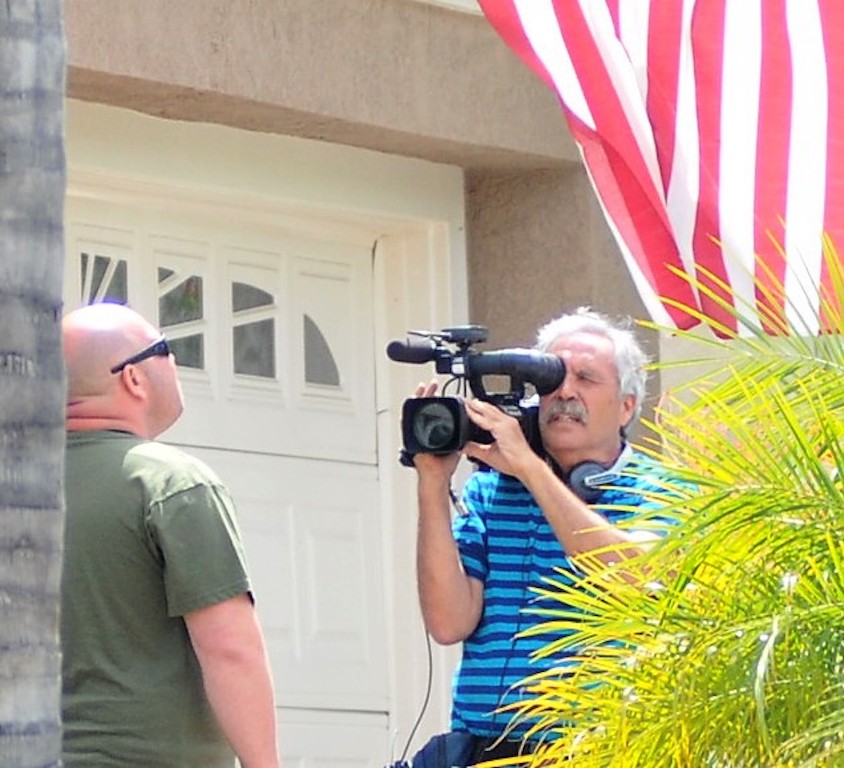
Det. John Mancini of Orange PD, left, is filmed by videographer Mark Kiss of the Santa Ana PD during the making of a training video produced by the OPD. Mancini plays the role of a suicidal Army veteran with PTSD. Photo by Lou Ponsi/Behind the Badge OC
Loucks also has worked with Orange PD officers and has been a consultant on the video productions, Amat said.
“She has assisted with the videos by coordinating the subject matter experts as well as assisting with the video interviews and scenarios over the years,” Amat said.
The videos have been distributed around the country and used as part of training law enforcement professionals, Amat said.
Since the videos are being seen by law enforcement personnel, maintaining realism is critical, said Mark Kiss, a video specialist with the Santa Ana Police Department, who has shot and edited the videos.
Real police tactics, including how far away from a distraught man an officer would be standing and even whether an officer would be wearing sunglasses in a certain situation, are considered, Kiss said.

During the taping of a police training video, Orange PD Cpl. Mark Bailey removes the hose from an SUV’s exhaust pipe in an effort to save the life of a suicidal Army veteran with PTSD, who is behind the wheel. Photo by Lou Ponsi/Behind the Badge OC
“It’s not going to be Rambo or a TV cop who comes pulling up, wheels tearing, throwing open a door and smacking him,” Kiss said. “We have to be legitimate with our tactics. Law enforcement officers are going to be zeroing in on the tactics … the weaponry.”
Orange PD command staff came up with the idea to produce the videos several years ago, Amat said.
While the videos are high quality, they are produced with a minimum amount of city funds, Amat said, with much of the funding coming from donations by local community groups.
“We are very fortunate to have the support of our department,” she said. “I’ve learned how much work really goes into it behind the scenes, but I think more importantly, I’ve learned specifically about these mental illnesses.”
The PTSD video likely will be the last one produced by the Orange PD, Amat said, but she is not ruling out the possibility of making more videos in the future.
“If another important topic comes up and needs to be addressed, I can see us picking it up and running with it,” Amat said.

Videographer Mark Kiss, right, shoots a scene for an Orange PD training video that will address the proper way for officers to approach a person with PTSD. From left are OPD Cpl. Mark Bailey, Sgt. Jennifer Amat and Officer Kyle Bean. Photo by Lou Ponsi/Behind the Badge OC
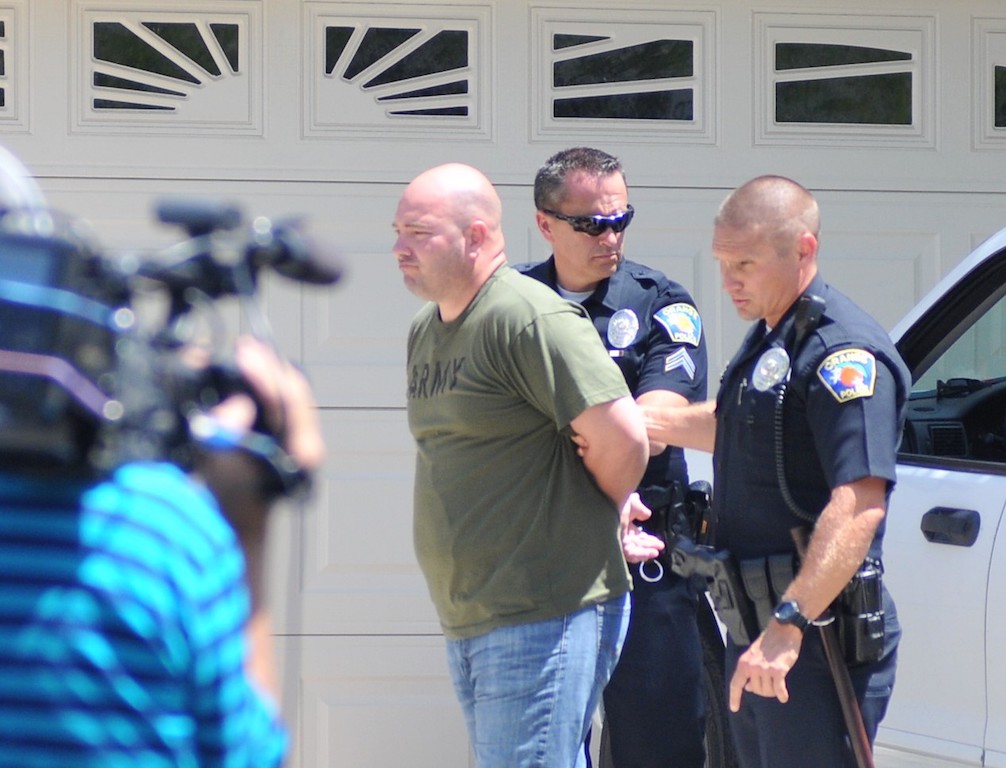
Orange PD Det. John Mancini (green T-shirt) plays the role of a suicidal Army veteran suffering from PTSD. He is being led away by OPD Cpl. Mark Bailey (wearing sunglasses) and Officer Kyle Bean. Photo by Lou Ponsi/Behind the Badge OC
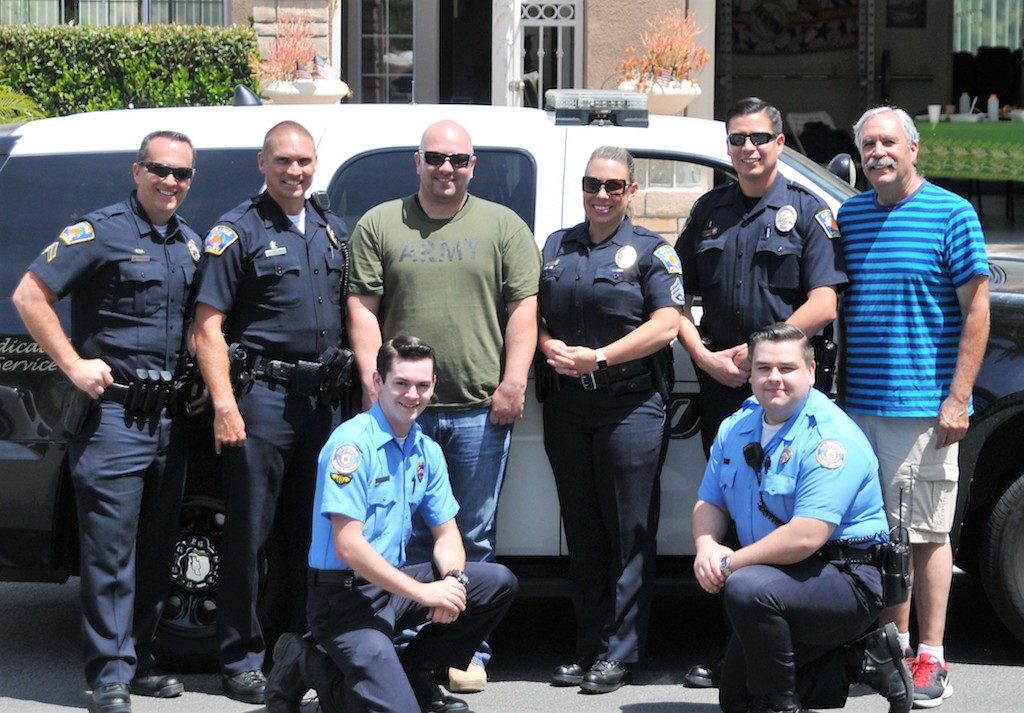
Group photo of Orange PD officers and cadets after shooting scenes for a training video. Photo by Lou Ponsi/Behind the Badge OC
 Behind the Badge
Behind the Badge
